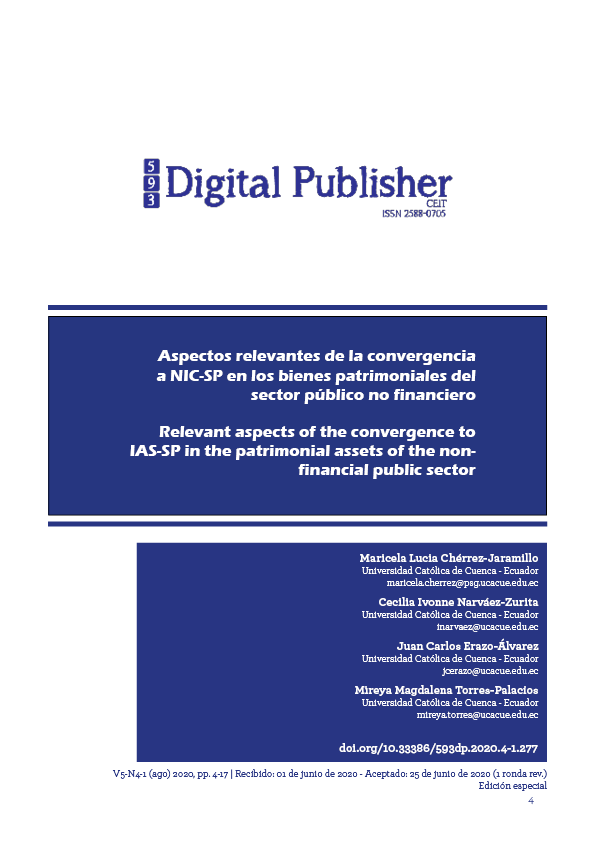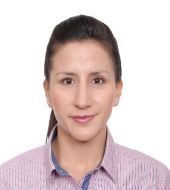Relevant aspects of the convergence to IAS-SP in the patrimonial assets of the non-financial public sector
Main Article Content
Abstract
The International Accounting Standards focused on the public sector (IPSAS) issued by the International Standards Council (IPSASB), constitute high standards in the management of financial-accounting information. Currently, several countries in the world have adopted these standards, as is the case of Ecuador. The Azogues Municipal Autonomous Decentralized Government (GADMA), faced with the need to recognize and register heritage assets in the financial statements, carried out the present study; The objective of the investigation is to propose a process for the implementation of IAS-SP 17 for the recognition of heritage assets. The methodology used in this research was non-experimental and cross-sectional, since the variables were analyzed in their natural state and at a single moment in time. The diagnosis determined the non-existence of a specific rule that controls heritage assets, its inventory was last carried out more than ten years ago by the National Heritage and Cultural Institute (INPC) and not by the GADMA, the vast majority of these assets are not under the domain of the institution. It is concluded that with the implementation of IAS-SP 17, reliable information will be obtained for the recognition of the assets of the Municipality, which must be registered in the account of Assets of National Historical Artistic and / or Cultural Heritage, as is the case of the Municipal cemetery, the Rodrigo Pesántez Museum and the Quinta San José; With this, the entity will present reasonable financial statements.
Downloads
Article Details
1. Derechos de autor
Las obras que se publican en 593 Digital Publisher CEIT están sujetas a los siguientes términos:
1.1. 593 Digital Publisher CEIT, conserva los derechos patrimoniales (copyright) de las obras publicadas, favorece y permite la reutilización de las mismas bajo la licencia Licencia Creative Commons 4.0 de Reconocimiento-NoComercial-CompartirIgual 4.0, por lo cual se pueden copiar, usar, difundir, transmitir y exponer públicamente, siempre que:
1.1.a. Se cite la autoría y fuente original de su publicación (revista, editorial, URL).
1.1.b. No se usen para fines comerciales u onerosos.
1.1.c. Se mencione la existencia y especificaciones de esta licencia de uso.
References
Banco Interamericano de Desarrollo. (2017). Estado de adopción de NICSP en los países de Latinoamérica y el Caribe. Banco Interamericano de Desarrollo. Auditora Independiente EY.
Contraloría General del Estado. (2016). Reglamento General para la administración, utilización, manejo y control de bienes y existencias del sector público. Quito, Pichincha, Ecuador: Registro oficial.
Deloitte Accountants . (2019). Las NICSP en su bolsillo (Vol. I). (S. A. Mantilla, Trad.) Bogota, Colombia: Deloitte Touche Tohmatsu Limited.
Dirección de Transferencia del Conocimiento Instituto Nacional de Patrimonio Cultura. (2011). Instructivo para fichas de registro e inventario de bienes muebles (Vol. 1). Quito, Pichincha, Ecuador: Ediecuatorial.
Dolores Ortiz Soto, C. N. (2019). Incidenciaen la aplicación de la NIC SP17 Propiedad, Planta y Equipo en las Empresas Municipales de Agua Potable. CIENCIAMATRIA , 1 (Volumen especial), 22.
Federación Intrnacional de Contadores- IFAC. (2003). NIC-SP 17 Inmuebles, maquinaria y equipos (Vol. 1). New York, New York, United States of Americas: IFAC.
FOCAL. (2019). CContabilidad Gubernamental en América Latina y convergencia a las Normas Internacionales de Contabilidad del Sector Público. Brasilia, Brasil: FOCAL.
Gad Muncipal de Azogues. (2016). Estatuto Orgánico por procesos. Azogues, Cañar, Ecuador: Registro oficial.
Glenda Mavel Lozano Calero, C. I. (2019). Procedimientos de control y registro contable bajo NIC SP para los activos del Gobierno Autónomo Descentralizado Parroquial de Fundochamba de la provincia de Loja. Visionario digital , 3 (2,1), 388.
IFAC. (2017). Manual de Pronunciamientos Internacionales de Contabilidad del Sector Público (Vol. 1). New York, NeW York, USA: IFAC.
Instituto Nacional de Patrimonio Cultural. (2014). Patrimonio Cultural Material. Loja, Loja, Ecudor: INPC.
Lobo, J. (2013). Medición y Valoración de los Activos bajo IFRS. Cartagena de Indias, Cartagena, Colombia.
Ministerio de Coordinación de la Política y Gobiernos Autónomos Descentralizados. (2017). COOTAD. Quito, Pichincha, Ecuador: V&M Gráficas.
Ministerio de Economía y Finanzas del Ecuador. (2019). Instructivo para la ocnvergencia de la Normativa de Contabilidad Gubernamental a NICSP a partir de 1 Enero del 2020 (Vol. Primera). (M. d. Economía, Ed.) Quito, Pichincha, Ecuador: Ministerio de Finanzas y Economía.
Ministerio de Finanzas del Ecuador. (2016). ACUERDO MINISTERIAL 0067 (Vol. 1). Quito, Pichincha, Ecuador: Ministerio de Finanzas.
Ministerio de Finanzas y Economía del Ecuador . (2019). Catálogo general de cuentas contables del sector público no financiero (Vol. 2). Quito, Pichincha, Ecuador: Ministerio de Finanzas y Economía del Ecuador .
Péres, O. V. (2018). Convergencia a Normas Internacional de Contabilidad para el Sector Público Nicsp: comparitivos de los modelos de Colombia y Chile. Javeriana , 01, 36.
Pincay, J. S. (2013). La Contabilidad Pública en América Latina y El Devengo en Ecuador. Analítika , 6 (2), 29.
Subsecretaria de Contabilidad Gubernamental. (2020). Instructivo para la Convergencia de la Normtiva de Contabilidad Gubernamental a NICSP a partir del 1 enero del 2020 (Vol. 1). Quito, Pichicna, Ecuador: Subsecretaria de Contabilidad Gubernamental.
Universidad de Costa Rica. (2018). Universidad de Costa Rica. (U. d. Rica, Productor) Obtenido de http://www.cicap.ucr.ac.cr/web/el-abc-de-las-normas-internacionales-de-contabilidad-del-sector-publico-nicsp-en-costa-rica-2/
Universidad de los Andes Venezuela. (2019). Elementos claves de las Normas Internacionales del Sector Público: Un aporte para el sistema de Contabilidad General . Visión Gerencial , 18 (2), 194.
Universidad Externado de Colombia. (2015). Metodología de reconomiento, valuación, medición y revelación de los bienes de uso público e históticos y culturas de acuerdo con la NICSP 17 en Colombia. Colombia.





